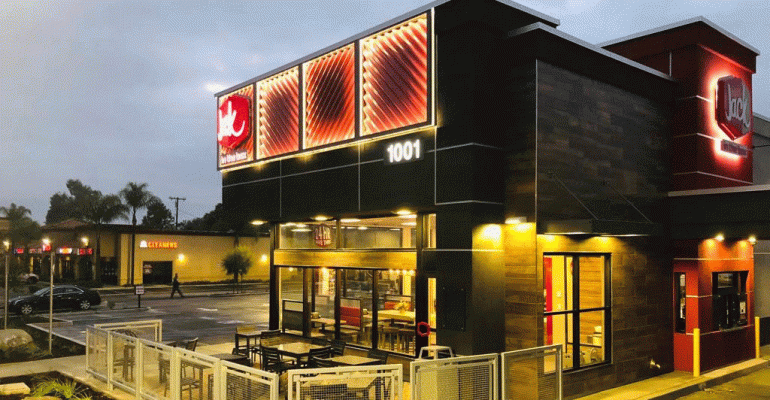Jack in the Box is experimenting with streamlined menus, adding new equipment, focusing on value bundles and overhauling its drive-thrus to increase same-store sales, which nearly flatlined in the final quarter of the year.
For the quarter ended Sept. 30, Jack in the Box reported a 0.5-percent increase in systemwide same-store sales.
CEO Lenny Comma said Jack in the Box, like the rest of the industry, “experienced a slowdown in September.”
He said restaurants from quick service to casual dining remain very aggressive when it comes to deep discounting. He noted extreme promotions such as $1 French fries and 10 chicken nuggets for $1. He didn’t name brands, but those fall deals were by Wendy’s and Burger King, respectively.
“Across the entire industry there almost seems to be a desperation for same-store sales and transactions,” he said when announcing the results.
Comma said Jack in the Box wouldn’t play directly in that space, but would instead focus on value through combo meals. He said the chain would offer “complete meal” bundles ranging in price from $4 to $6, adding that data shows that if the brand doesn’t offer a value meal hovering around $5, consumers tend to go elsewhere.
“It’s ultra-important right now,” he said of a value strategy.
The brand also plans to focus on remodeling restaurants, and overhauling drive-thrus.
Jack in the Box remodeled 42 restaurants in 2018, and Comma said the chain would double that number in fiscal 2019.
Other upgrades are underway as well: Comma said about 80 percent of the company’s drive-thru lanes would be upgraded by the end of fiscal 2021.
Although no further specifics were revealed, in a previous earnings call, the San Diego-based chain said it would spend up to $45 million over the next three years adding digital menu boards and assigning tablet-holding order-takers to drive-thru lanes.
In-N-Out Burger and Chick-fil-A, which consistently rank high in consumer satisfaction surveys, have deployed order-takers in their drive thru lanes for years.
In about 150 stores, Jack in the Box also is testing streamlining back-of-the-house operations by eliminating redundant foods and complicated meal assembly processes, Comma said.
What’s not important to him?
Despite launching its app in October, Comma said he didn’t see digital and delivery as big drivers for the brand. The company is only playing in that space to address the veto vote for consumers who want that convenience, he said.
“It’s necessary to keep the guests that we have, but I don’t know necessarily it will grow our guest counts,” he said.
Total revenue for the quarter declined to $177.5 million compared to $232.1 million for the same quarter last year. Net profit of $16.3 million, or 68 cents per share, decreased from $30 million, or $1.05 per share, from the same quarter last year.
The reduction was due in part to discontinued operations tied to the sale of Qdoba.
Restaurant analyst Peter Saleh of BTIG called the chain’s results “uninspiring” with earnings partially dragged down by “industry weakness in September.” The chain’s same-store sales increase of .5 percent came in well below BTIG’s 1.5 percent forecast.
“We struggle to identify a sustainable catalyst,” he wrote in a Tuesday morning report.
Besides industry challenges, Jack in the Box’s leadership is facing internal obstacles.
The National Jack in the Box Franchisee Association called for the removal of Comma in early October after a vote of no confidence. On Monday, the association, which represents franchise owners who operate about 2,000 restaurants, questioned a recent corporate overhaul of real estate leases.
The group, in a complaint made with California regulators, said operators ‘might be in danger of losing’ leases. Jack in the Box has asked property owners to transfer their lease agreements from Jack in the Box Inc. into a newly formed subsidiary, Jack in the Box Properties LLC, according to a letter obtained by the franchisee group.
Comma did not address the real estate restructuring, which is being done to increase the chain’s credit worthiness in the event it plans to secure new financing.
However, chief financial officer Lance Tucker told analysts that the franchise group’s concerns are “fair but unfounded.”
The real estate changes do not negatively “impact franchise’s rights one bit,” he said.
In the conference call, Comma addressed the overall tensions between the company and franchisees.
He said rising costs of labor have put pressure on franchisees, so they have “anxiety” about earnings. He said the company is actively working with them to bring up top-line sales.
Discussions about those topics often result in a “spirited debate” with franchisees, who are vital to Jack in the Box’s success, he said.
Comma said the company understands their concerns and “there’s never been any questions that our goals are fully aligned.”
The franchisee group has also questioned the chief marketing officer vacancy.
In September, CMO Iwona Alter officially exited the company. In a quarterly regulatory filing, Jack in the Box said the company "no longer need[ed] her services." Alter, CMO for two years, had been with the company since 2005.
She has since accepted a role as chief brand officer for Irvine, Calif.-based The Habit Restaurants, Inc.
Comma said he’s confident in the marketing executives currently running the chain’s programming. He said he’s going to take the time necessary to fill the CMO role and to do “what’s right for the brand.”
He said he’s looking at redefining the position by bringing in someone who understands where the industry is going, not where it’s been because “the industry is anything but traditional today,” he said.
During the quarter, the company said it completed its refranchising initiative with the sale of eight Jack in the Box restaurants. Roughly 94 percent of the company’s 2,251 restaurants are franchises.
Contact Nancy Luna at [email protected]
Follow her on Twitter: @fastfoodmaven





